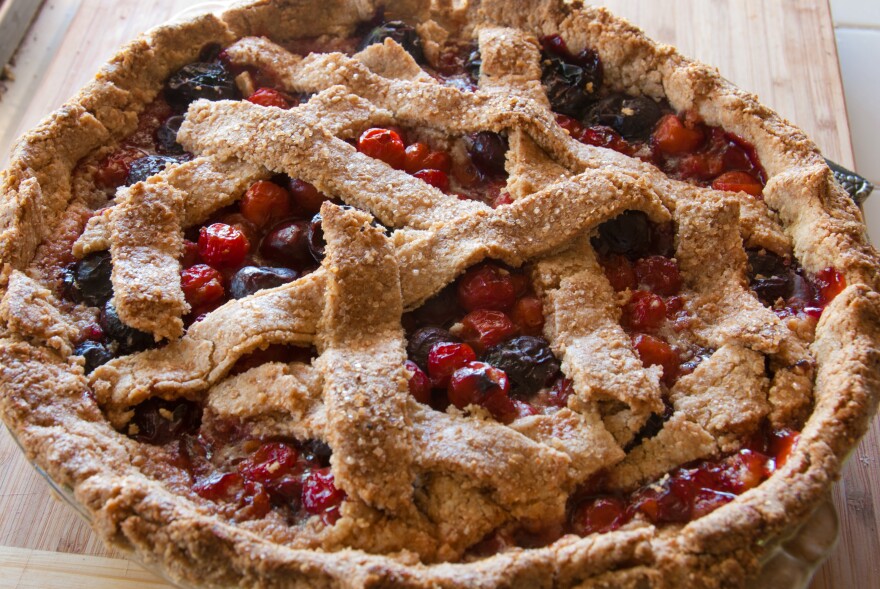Given the sheer abundance of fruit available to us now, it is natural to think about making some pies. As tempting an idea as this is, I used to be put off by the seeming complexity and futility of making a good pie crust. But not any more. Having learned a few crucial secrets, I am now qualified to turn out a lovely flakey crust just about every time. And Chef Jerry Pellegrino often mentions, we don't have to stop with basic crust either.
Technically there are three types of classic pie crust. The French named them and here they are…pâte brisée, pâte sucrée , pâte sablée.
Pâte brisée, or broken crust, is our basic pie crust that we are all familiar with. It depends on chilled pieces of fat being worked into the flour, which when baked will melt and create the flaky texture we want. While butter is the most commonly used fat, some bakers swear by shortening or even lard, either by themselves or in combination with butter. This is the crust you want for basic pies, meat pies and quiches. The key: get every single ingredient and utensil really cold.
Pate sucrée is a sweet crust. In addition to sugar added to the flour, it is also thickened with a raw egg yolk. This creates what we would call a "short crust" meaning the proportion of fat to flour is higher, and it tends to crumble. This is a great crust for sweet fruit pies.
Pate sablée, means sandy crust, and this refers to the higher amount of crunchy sugar that gets into the flour. In addition, nut meats like ground almonds are used to enhance the texture. (You'll also see recipes for graham cracker crust.) This is ideal for fruit tarts.
One thing we need to mention is you must absolutely have a pastry cutter on hand to work your flour and fat. We're talking about that multi-blade crescent shaped tool with a nice handle that perfectly works your chunks of butter into the dough.
Now for a few instructions.
Let's start with the pate brisée, or our basic pie crust. This is the one you make for apple pie. The most common complaint about this crust is that it isn't as flaky as advertised. The cure for this problem is very simple: wash your hands in very cold water... and chill everything before using, including your mixing bowl and your bag of flour. Cut up your ice-cold butter very quickly and work it into your ice-cold flour. You can blend by hand, or even better use a food processor. If you do use the old Cuisinart, be very careful not to overwork the dough. Once you have your ball of dough made, cut it in two and then refrigerate for at least an hour. After that, roll it out to size and place it in your pie tin.
The pate sucrée is a bit different. Using a food processor, you start with your flour, and then add the correct amount of sugar, most often confectioner's sugar. You pulse these together until you get a slightly grainy texture. Next come the cubes of cold butter. Pulse again, and the dough becomes even more grainy. Now you add the final touch, a mix of one whole egg, a tablespoon of cold water and a pinch of salt. Pulse the processor and watch a ball of dough form. As soon as that dough forms a rough ball, STOP. Take it out, shape it and then refrigerate it.
The pate sablée uses even more sugar which results in a very crumbly crust. In addition you might use things like ground almonds or ground up graham crackers to add to the texture. Bakers will also add chocolate to this crust for a tasty variation.
One surprising variation of this simple recipe is to include grated hard-boiled egg yolks in the flour. This technique, espoused by baker Paula Peck was handed down from her mother who thought the grated yolks added to the richness of the dough.
Almost always, the pate sablée crust is formed in its pie tin and blind baked. This procedure is especially useful when using a very moist filling. The pre-baking makes sure the bottom is done, and does not result in a soggy bottom.
Going back to our simple pate brisée apple pie crust. My good friend and expert baker Sandy Kushner says rather than blind baking the bottom crust, go buy cheap thin metal pie pans instead. Place the completed raw pie near the bottom heating element, and the thin metal will bake the bottom perfectly.
And how long to bake our pies? Sandy says use a 400° oven, and keep the pie in there until the filling begins to bubble up and spill out of the vent holes. This will guarantee a perfectly baked pie.





